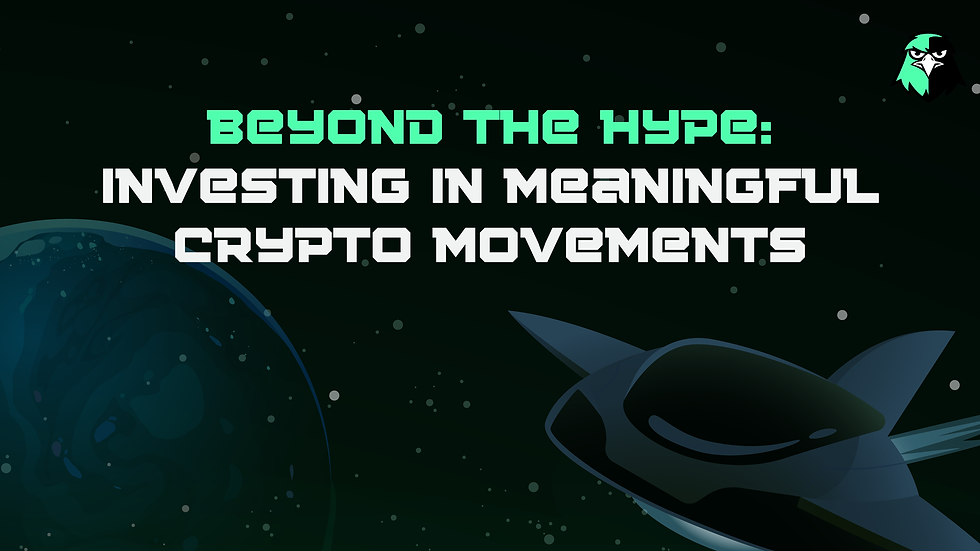The Emergence of Decentralized Physical Infrastructure Networks (DePIN)
- Falcons Inu Blog

- Dec 8, 2024
- 3 min read
Updated: Dec 16, 2024

Imagine if the infrastructure that powers our physical world—think of things like telecommunications, energy grids, or even transportation networks—was no longer controlled by a handful of large corporations but instead managed by communities of individuals around the globe. This is what decentralized physical infrastructure networks (DePIN) aim to achieve. It’s a big shift, but it feels like the natural next step as more aspects of our lives become decentralized.
What Exactly Are DePIN?
At its core, a decentralized physical infrastructure network is a way to build, operate, and maintain physical infrastructure using decentralized networks. Unlike traditional systems where a single entity owns and manages resources, DePIN relies on multiple participants, often individuals, contributing to and benefiting from the system.
Let’s break it down with an example. Think of how ride-sharing platforms like Uber or Lyft work. The platform itself doesn’t own cars; individual drivers do. In a DePIN model, the drivers wouldn’t just provide the rides—they’d also be part of managing and maintaining the network, earning rewards in return. DePIN takes this concept further, applying it to critical infrastructure such as internet connectivity, energy distribution, and more.
How Does DePIN Work?
The beauty of DePIN lies in how decentralized technologies like blockchain or distributed ledgers come into play. These technologies ensure that participants can trust one another without needing a central authority. Here’s a simple breakdown of how it works:
Contribution of Resources: Individuals or small organizations provide infrastructure, whether it’s a physical asset like a solar panel or a service like internet bandwidth. They become "nodes" in the network.
Incentives: Instead of being paid through a central company, participants earn tokens or another form of digital rewards for their contributions, encouraging more people to join the network.
Governance: Decisions on how the infrastructure is managed are made by the participants themselves, often through a decentralized system of voting or staking tokens.
Real-World Examples
One of the most talked-about examples of DePIN is Helium, a decentralized network providing wireless communication. Instead of building traditional cell towers, Helium relies on individuals to set up hotspots in their homes or businesses. These hotspots form a decentralized wireless network that others can use, and in return, the hotspot owners earn tokens. This way, the infrastructure for wireless communication is spread out, and individuals directly benefit from their contributions.
Another example is Filecoin, a decentralized storage network where individuals can rent out their unused storage space. By participating in the network, they contribute to a global system of file storage, getting paid in tokens for the space they provide. This is a great example of how DePIN allows physical resources—in this case, storage hardware—to be pooled together for the benefit of all.
Why Does DePIN Matter?
DePIN shifts control from large corporations to individuals, allowing for more local ownership and participation in infrastructure development. It also lowers barriers for entry. You don’t need to be a massive company to provide services like internet access or energy—anyone with the right resources can join the network and contribute.
Beyond that, it has the potential to create more resilient systems. By distributing resources across many different participants, DePINs reduce the risks associated with central points of failure. In traditional systems, if a major utility or service provider experiences an outage, millions of people can be affected. With DePIN, the network remains functional even if some participants go offline.
Looking Ahead
As the idea of decentralization spreads from digital assets to physical resources, DePIN is likely to play a growing role in how we build and manage infrastructure. For individuals, it offers the opportunity to be more than just passive consumers. You can actively participate in the systems that power your life and get rewarded for it.
We’re still in the early days of DePIN, but the potential is clear. It’s a shift in how we think about infrastructure—no longer top-down, but something we all have a stake in. And while we may not be there just yet, it’s exciting to imagine a world where the infrastructure we rely on every day is owned and operated by the people, for the people.
As we continue to explore the potential of decentralized systems like DePIN, staying updated on the latest trends in crypto and blockchain is essential. For more insights, tips, and discussions on these topics, be sure to follow FalconInu for all things crypto-related. Stay informed, stay ahead!




Comments